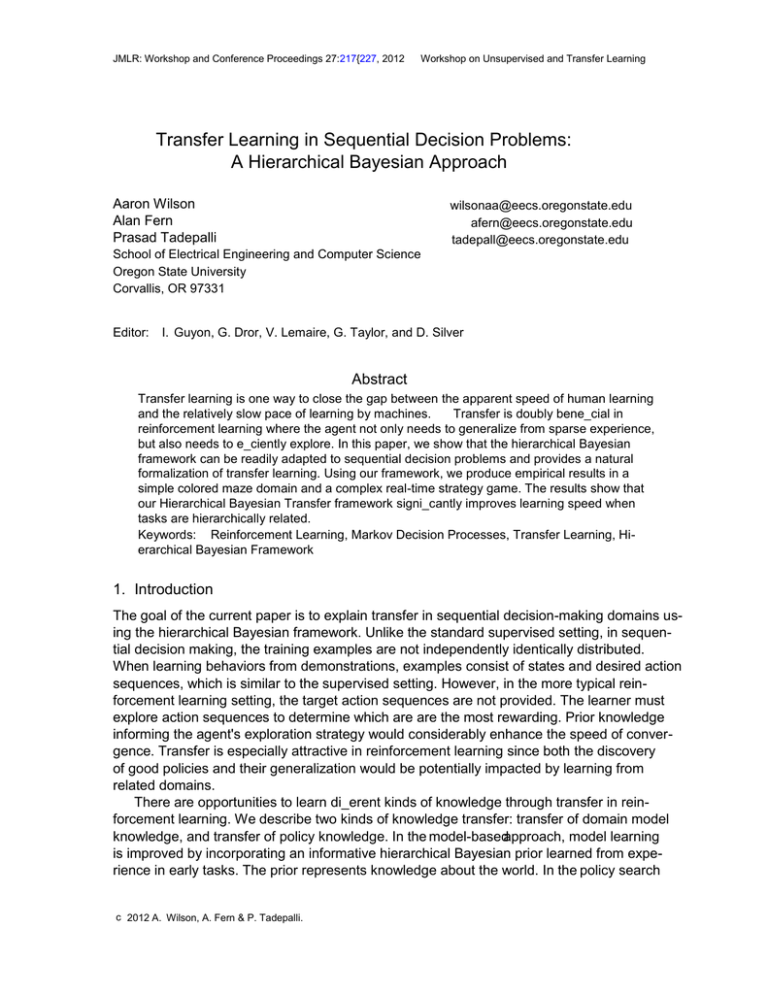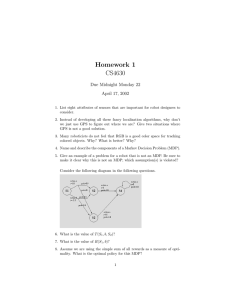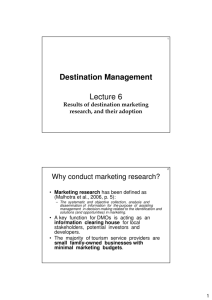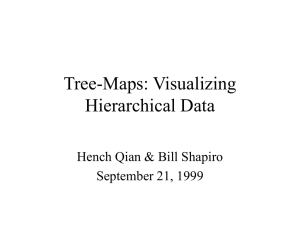Transfer Learning in Sequential Decision Problems A Hierarchical Bayesian Approach
advertisement

JMLR: Workshop and Conference Proceedings 27:217{227, 2012
Workshop on Unsupervised and Transfer Learning
Transfer Learning in Sequential Decision Problems:
A Hierarchical Bayesian Approach
Aaron Wilson
Alan Fern
Prasad Tadepalli
wilsonaa@eecs.oregonstate.edu
afern@eecs.oregonstate.edu
tadepall@eecs.oregonstate.edu
School of Electrical Engineering and Computer Science
Oregon State University
Corvallis, OR 97331
Editor:
I. Guyon, G. Dror, V. Lemaire, G. Taylor, and D. Silver
Abstract
Transfer learning is one way to close the gap between the apparent speed of human learning
and the relatively slow pace of learning by machines.
Transfer is doubly bene_cial in
reinforcement learning where the agent not only needs to generalize from sparse experience,
but also needs to e_ciently explore. In this paper, we show that the hierarchical Bayesian
framework can be readily adapted to sequential decision problems and provides a natural
formalization of transfer learning. Using our framework, we produce empirical results in a
simple colored maze domain and a complex real-time strategy game. The results show that
our Hierarchical Bayesian Transfer framework signi_cantly improves learning speed when
tasks are hierarchically related.
Keywords: Reinforcement Learning, Markov Decision Processes, Transfer Learning, Hierarchical Bayesian Framework
1. Introduction
The goal of the current paper is to explain transfer in sequential decision-making domains using the hierarchical Bayesian framework. Unlike the standard supervised setting, in sequential decision making, the training examples are not independently identically distributed.
When learning behaviors from demonstrations, examples consist of states and desired action
sequences, which is similar to the supervised setting. However, in the more typical reinforcement learning setting, the target action sequences are not provided. The learner must
explore action sequences to determine which are are the most rewarding. Prior knowledge
informing the agent's exploration strategy would considerably enhance the speed of convergence. Transfer is especially attractive in reinforcement learning since both the discovery
of good policies and their generalization would be potentially impacted by learning from
related domains.
There are opportunities to learn di_erent kinds of knowledge through transfer in reinforcement learning. We describe two kinds of knowledge transfer: transfer of domain model
knowledge, and transfer of policy knowledge. In the model-basedapproach, model learning
is improved by incorporating an informative hierarchical Bayesian prior learned from experience in early tasks. The prior represents knowledge about the world. In the policy search
c 2012 A. Wilson, A. Fern & P. Tadepalli.
Wilson Fern Tadepalli
approach, a prior is placed on the policy parameters themselves. The prior represents direct
knowledge of what the agent should do. In each approach, it is assumed that there is a
small but unknown number of component types which can be learned and transferred to
new tasks. When the discovered components can be reused Transfer is successful.
2. Sequential Decision Problems and Hierarchical Transfer Hypothesis
We formulate the transfer learning problem in sequential decision making domains using
the framework of Markov Decision Processes (MDPs). An MDP M is de_ned by a 6-tuple
( S;A;C;T;I;F ), where S is a set of states andA is a set of actions.C ( s;a ) is the immediate
cost of executing action a in state s. Function T ( s;a;s 0) de_nes the probability of reaching
state s0 given that action a is taken in state s. I is a distribution of initial states and F is a
set of _nal or terminating states. A policy _ for M is a mapping from S to A . The expected
cost of a policy _ starting from a state s is the cumulative sum of action costs starting from
state s, and ending when the agent reaches a terminating state. A solution to an MDP is
an optimal policy that minimizes the total expected cost from all states.
The minimum
expected cost from state s is the unique solution to the following Bellman equations:
_
V ( s) =
_ 0 if s is a terminal state
min a C ( s;a ) + P s0( T ( s;a;s 0) V _(0s )) ; else
The actions that minimize the right hand side of this equation constitute the optimal policy.
While most work in RL is concerned with solving a single unknown MDP (task), here
we are concerned with transfer across MDPs. Our objective is to develop a lifelong learning
algorithm that is able to leverage experience in previous MDPsM;:::M
1
n to more quickly
learn an optimal policy in a newly drawn MDP M n +1 . If each task faced by an agent is
arbitrarily di_erent from the previous tasks, the agent has no way to bene_t from having
solved the previous tasks. To explain the apparently fast learning of people, and duplicate
this learning speed in machines, we explicitly formulate thehierarchical transfer hypothesis
.
It is the claim that tasks have a latent hierarchical relationship, which can be explicated
and exploited to transfer knowledge between tasks. We propose a hierarchical Bayesian
framework to capture the task similarities. We apply this framework to both model-based
RL and to model-free policy search. In model-based RL, the hierarchy represents similarities
between MDP models. In the policy search approach, the hierarchy represents similarities
between policies. Below we discuss each of these approaches in more detail.
3. Hierarchical Model-Based Transfer
In this section, we outline our hierarchical Bayesian approach to model-based transfer for
RL problems. Figure 1( a ) (bottom) illustrates our fundamental assumptions of the task
generation process. Classes of MDPs are generated from a task prior distribution, and each
task generates an MDP. The hierarchical structure assumes that each MDP M i is an iid
sample from one of the unobserved classes. We propose a hierarchical prior distribution,
based on the Dirichlet Process (DP), in order to capture this hierarchical structure.
We
aim to exploit this structure when exploring new tasks.
218
Transfer Learning in Sequential Decision Problems
G0
Task prior
(a)
c
MDP
MDP
MDP
Task Class
Prior
(b)
Induced Distribution
Over Task Class 1
Models
MDP
MDP
MDP
Induced Distribution
Over Task Class 2
Models
MDP
MDP
Induced Distribution
Over Task Class N
Models
MDP
MDP
MDP
MDP
ci
Mi
(s,a,r,s’,a’) R
N
( a)
( b)
Figure 1: (a) (top) Single task Bayesian RL vs. (bottom) Hierarchical Model-Based Transfer. The number N and parameters of the induced distributions are learned
from data. (b) The corresponding In_nite Mixture Model (Parameter set ).
The task prior is represented by G0, task class distributions have parameters _,
classes are indexed by c,
M i represents thei th MDP model parameters, the tuples
0 0
( s;a;r;s;a ) are the observed transition and reward data, and _ is the Dirichlet
Process concentration parameter.
We describe the generative process for MDP models using Figure 1(
b) . The generative
model is shown in plate notation. Rectangles indicate probability distributions that are
replicated a certain number of times. The number of replications is shown in the bottomright corner of each plate. The _gure shows a distribution overN MDPs. In each MDP the
agent has madeR observations. Each classC = c is associated with a vector of parameters
_c. These parameter vectors de_ne distributions from which individual MDPs will be drawn.
The parameters ci indicate the class of MDP M i . G0 is a distribution over classes that
corresponds to the Task Class Prior in Figure 1( a ) (bottom). Finally the parameter _ is
the concentration parameter of the Dirichlet Process (DP) model. refers to the tuple of
parameters
= _;c;_
(
). The DP generalizes the case of a known _nite number of MDP
classes to a in_nite number of classes. This non-parametric model allows us to (a) model a
potentially unbounded number of classes, (b) adapt to and make inferences about classes we
have not seen before, and (c) learn the shared structure that constitutes each class, rather
than prede_ning class speci_cations.
The key steps in our approach to exploiting this model are outlined in Algorithm 1. The
Hierarchical DP model is used as a prior for Bayesian RL in a new MDP. Before any MDPs
are experienced, the hierarchical model parameters
are initialized to uninformed values.
The Sample function (line 5) uses the DP model to generate a sample of several MDPs from
219
Wilson Fern Tadepalli
Algorithm 1 Hierarchical Model-Based Transfer Algorithm HMBT
1: Initialize the hierarchical model parameters
2: for each MDP M i from i = 1 ; 2;::: do
3:
Oi = ; //Initialize the set of observation tuples (s,a,r,s',a') for M i
4:
while policy _ has not convergeddo
5:
M^ i
))
Sample( P ( M j O;i
6:
_ = Solve ( M^ i ) //Solve the sampled MDP using value iteration.
7:
Run _ in M i for k steps.
8:
Oi = Oi [f observations from k stepsg
9:
end while
^1
^ i )) //Given _xed estimates of the MDP model param10:
Sample( P ( j M;:::;M
eters generate samples from the posterior distribution and select the best.
11: end for
Pr( M i j O;i
From
). this sample, the M^ i with the highest probability is selected. To select
an action we solve M^ i using value iteration (line 6) and then follow the greedy policy for
k steps (line 7). Observations gathered while executing the greedy policy are added to the
collection of observation tuples Oi for the current MDP. Next, the posterior distribution
is updated, and a new sample of MDPs is taken from the updated posterior distribution.
This loop is repeated for MDP M i until the policy has converged. After convergence, we
update the hierarchical model parameters
based on the parameter estimatesM^ i . This
is done using the SampleMap procedure. SampleMap uses the machinery of the DP to
^1
^ i . Given the assignments, we
assign (possibly new) classes to each observed MDP
M;:::;M
compute the parameters associated with each class distribution. This process is iterated
until convergence. Intuitively, as the agent gains experience with more tasks, the samples
generated by this procedure will tend to represent the hierarchical class structures generating
the MDPs. Learning speed will improve if a new task is usefully described by the sampled
hierarchical structure. Details for this algorithm, including speci_cations of the posterior
sampling algorithm, are found in Wilson et al. (2007).
Experimental Results.
To test our hypotheses, we consider a simple colored maze
domain. An example maze is shown in Figure 2. The goal of the agent is to traverse the least
cost path from the start location to the _nal goal location. To do so, the agent may navigate
to adjacent squares by executing one of four directional actions. The agent's reward function
is a linear function combining the costs of all squares adjacent to the agent's location on
the map. The contributed cost of each adjacent square is a function of its color. To do
well, the agent must determine which colors have low cost and identify a path minimizing
the total cost from start to _nish. In the multi-task setting the parameters of the reward
function, governing the penalty for traversing certain colors, characterize each task, and are
assumed to be generated from a hierarchical structure. To generate a task, the world _rst
generates a class and then generates a vector of color costs from the sampled class. Each
map is randomly colored before the agent begins its interaction.
In the _rst instance of this domain the goal location is _xed. The agent must traverse
from the top left to the bottom right of the map. The objective is to maximize the total
reward per episode. Episodes end only after the goal is reached. Map squares have 8
220
Transfer Learning in Sequential Decision Problems
S0
G
Figure 2: The colored map domain. Tile squares are randomly colored. Each color has a
cost. When the agent lands on a square it receives a penalty proportional to the
cost of the occupied square and the costs of adjacent squares. The agent's goal
is to traverse the least cost path from the top left to the bottom right.
di_erent colors and reward functions are generated from 4 distinct classes. Figure 3 shows
results for this setting. Good performance is possible with a small number of steps in each
sampled MDP. Even so the bene_t of transfer is obvious. Given experience in 16 MDPs the
number of exploratory moves is reduced from 2500 to 100 steps { an order of magnitude
di_erence. The curves also indicate that the algorithm avoids negative transfer. Exploring
according to the learned prior results in consistently improved performance even when early
tasks are not related to the current task.
In order to better illustrate the bene_t of transfer, we consider a more di_cult problem.
We no longer assume that goal locations are _xed. Instead, goal locations are sampled from
a hierarchical distribution. This confounds the exploration problem for uninformed agents,
which must now identify the goal location and the color costs. Termination is achieved when
the agent _nds the goal location. We present results for larger maps, 30x30 squares, with 4
underlying classes of goal locations (each class has goal locations distributed around a _xed
map square). Results are shown in Figure 4. The graph depicts the average performance
in the _rst episode given a _xed number of prior tasks.
By comparison, we show the
performance of the algorithm with zero prior tasks. Improvements indicate a reduction in
the number of steps needed to _nd the goal. The observed improvement in average total
reward is dramatic. After ten tasks the agent has inferred a reasonable representation of
the hierarchical structure that generates the goal locations. Knowledge of this hierarchical
structure reduces the exploration problem. The agent only checks regions where goals are
likely to exist. Exploiting this hierarchical knowledge reduces the cost of exploration by an
order of magnitude.
221
Wilson Fern Tadepalli
Figure 3: Learning curves for the _xed goal location problem.
after 0, 4, 8, and 16 tasks have been solved.
Performance is evaluated
Figure 4: Average cost of _nding the hidden goal location in the _rst episode. Performance
is a function of experience in previous tasks.
4. Hierarchical Bayesian Policy Transfer
The premise behind the hierarchical transfer hypothesis, as it applies to policy search, is
that policies are hierarchically composed of shared components. Our Bayesian Policy Search
222
Transfer Learning in Sequential Decision Problems
( a)
( b)
Figure 5: (a) A Wargus map. The friendly (red) team is composed of one ballista, seven
archers, and one knight. The agent's objective is to destroy the structures and
units on the blue team. The agent must select, at each time step, a target for
each unit on its team (targets can include friendly units). (b) The hierarchical
prior distribution for unit roles.
The set of parameters
includes: The prior
distribution on role parameters G0, the set of roles_c, the assignment parameters
_ , unit features f u , the concentration parameter of the DP model _ , the assignment variable for each unit cu , and the observed trajectory data _ generated by
executing role based policies. The plate notation indicates that there areN tasks
and each task is composed ofU units.
(BPS) algorithm learns these components in simple tasks and recombines them into a joint
policy in more di_cult tasks. In some cases, tasks that are impossible to tackle with no
prior knowledge become trivial if the necessary component set is learned from simpler tasks.
We pursue this basic idea in the context of a real time strategy game called Wargus.
The tactical conicts we consider include groups of heterogeneous units _ghting to destroy
one another. An example Wargus map is shown in Figure 5( a) . Units controlled by the
agent include a ballista, a knight, and several archers. Each unit has a set of physical
characteristics including armor, speed, location, and so on. These characteristics naturally
predispose units to particular roles in confrontations. For instance, due to its long range
the ballista is useful for destroying structures, while units close to key pieces (such as the
opposing ballista) may be best employed targeting those pieces. Therefore, we view a policy
for Wargus conicts as a composition of roles (components) and a means of assigning roles
to units (combining components). In practice, the agent does not know the number of roles,
the type of roles, or the correct method of assigning roles to units. Therefore, the goal of
our lifelong learning agents will be to learn (or be taught by example) a collection of roles
useful for a variety of confrontations and to adapt its method of assigning units to roles as
is appropriate for novel tasks.
Our approach to the role discovery and assignment problem is to de_ne a hierarchical
prior distribution for the set of individual agent roles, and then to search this structure using
223
Wilson Fern Tadepalli
stochastic simulation algorithms adapted to the policy search problem. We _rst de_ne a set
of policy components in the form of a parametric class of policies, then de_ne a hierarchical
Bayesian prior in the form of a modi_ed DP model, and _nally, we de_ne a means of
searching the policy space for solutions.
It is assumed that each unit in the game acts independently of the others given their
assigned roles. The distribution of the joint action for a set of agents, conditioned on the
assigned roles, is the product of the individual action choices, P ( A j s) = Q u P ( au j s;_ cu ) ;
where A is the joint action, cu is a role index for unit u, and each _cu represents the vector
of role parameters assigned to unit u.
The hierarchical prior distribution for the role parameters, which describes a joint policy
for all agents, is shown in Figure 5( b) . The prior illustrates how roles are combined and
associated with units in the game. There are N tasks. Each task is composed of U units.
Each unit is assigned a vector of role parameters _cu indexed by cu . The variable _u
represents a set of trajectories, a sequence of state-action observations, made by agentu
when executing its policy. Assignment of units to roles depends on unit-speci_c features
f u and a vector of role assignment parameters _ . The vector of assignment parameters _
represent a strategy for assigning the collection of units to roles. An instance of the role
assignment strategy is associated with each of the N tasks. The set of available roles _cu
is shared across all of the N tasks. Taken together, the set of parameters,
_;c;_;_
= ( ),
represents a joint policy for all observed tasks.
For purposes of searching the joint policy space we build on the work by Ho_man et al.
(2007). We de_ne an arti_cial probability distribution,
q(
/ U) (
P ( ) = P) (
Z
R)( _) P ( _j
d_; )
proportional to the prior distribution and a utility function.
For purposes of applying
this idea to the policy search problem the utility function is de_ned to be the expected
T
return for a policy executed in an episodic environment,V ( = E) ( P t =1 R( s;a
This).
t t )j
formulation allows us to adapt advanced methods of stochastic simulation, developed for
estimation of probability distributions, to the problem of policy search.
Essentially, the
prior distribution acts as a bias. It guides the search to regions of the policy space believed
to have a high return. The utility function plays a similar role. Samples drawn from q(
),
will tend to focus around regions of the policy space with high utility.
Given N previously observed tasks, we take the following strategy. We _x the set of
previously identi_ed roles and use this role set as prior knowledge in the new task. Discovery
of roles is a di_cult process. Therefore, role reuse in the new task can dramatically improve
learning speed. Within a new task we search for strategies that recombine these existing
roles and propose new roles to overcome novel obstacles. Algorithm 2 shown in Figure 2
is designed to implement this strategy by sampling role-based policies given the informed
prior.
The algorithm has four basic parts. We assume that trajectories of optimal policies are
available for the _rst N tasks. If no prior task is available the trajectory set will be empty.
Trajectories are stored to be used during inference. This brings us to the main body of
the sampling procedure, which generates samples from the arti_cial distribution q(
). On
line 5, after initializing the state of the Markov chain, the new role assignments are sampled.
224
Transfer Learning in Sequential Decision Problems
Algorithm 2 Bayesian Policy Search
1: Initialize parameters of the role-based policy: 0
2: Initialize the sets of observed trajectories: _ = ;
3: Generate n trajectories from the domain using 0 .
4: _
_ [f _i gi =1 ::n
5: S = ;
6: for t = 1 : T do
7:
//Generate a sequence of samples from the arti_cial distribution.
^ ( t 3 1) P ( t 3 1))
8:
Sample( U
t
9:
Record the samples:
10:
S
S[ ( t
)
11: end for
12: Set 0 = argmax ( t 2 S U () t
) //Select the role-based policy maximizing the expected
return.
13: Return to Line 2.
Each agent is placed into one of the existing components, or (using the mechanics of the
DP) a new component generated fromG0. Next, line 6 updates the role parameters using
Hybrid Markov Chain Monte-Carlo (Andrieu et al. (2003)). The key to this portion of the
algorithm is the use of gradient information to guide the simulation toward roles which yield
high expected return. Next, we perform a simple Metropolis-Hastings update for the vector
of assignment parameters. Finally, the role-based policy with highest predicted utility is
used to generate a new set of trajectories. The concrete implementation of each sampling
procedure can be found in Wilson et al. (2010), which includes details of the model-free
method of estimating the utility.
Experimental Results.
Our algorithm is agnostic about the process generating trajectories. Trajectories may be produced by an expert, or automatically generated by the
learning agent. Figure 6 illustrates the results of transfer from a simple map, when given
examples of expert play in the simple map, to a more complex map. An expert demonstrates 40 episodes of play in the simple map. The expert controls 6 friendly units. Given
the expertly generated trajectories, roles and an assignment strategy are learned using the
BPS algorithm. The agent attempts to transfer these learned roles to a more di_cult Wargus map where it will control 10 friendly units (see Figure 5( a) ). We compare the transfer
performance, BPS:Expert, to three baselines. The _rst two baselines (BPS Independent
and BPS Single) represent the BPS algorithm with an enforced role structure. In the Independent case, all units are forcibly assigned to their own role. In the Single case, all
units share the same role. In principle, BPS with the independent role structure can learn
the correct policy and this _xed role structure may be bene_cial when roles are not shared.
Similarly, if a single role will su_ce, then BPS run with all agents assigned to a single policy
will be ideal. Independent and Single baselines cannot make use of the role structure, and
therefore they cannot bene_t from transfer. Instead, they must learn their policies from
scratch. Finally, we compare our performance to OLPOMDP where units independently
learn a policy (Baxter et al. (2001)). Results are shown in Figure 6. The BPS algorithm
bene_ts substantially from identifying and transferring the expert roles.
225
Wilson Fern Tadepalli
Figure 6: Transfer results of BPS given expert examples of play and tested on a map with
10 units.
Figure 7: Transfer results of BPS algorithm given training in a simple map with 6 units
and tested on a map with 10 units.
Experts are not always available. Unfortunately, learning in our test map is more
di_cult when examples of expert play are not provided.
On the test map used above,
226
Transfer Learning in Sequential Decision Problems
which represents a large multi-agent system, it was di_cult to learn a good policy using
BPS without prior knowledge. To overcome this problem without resorting to expert help
we _rst allow BPS to learn a useful role structure in a simpler map (by observation of its
own behavior). Subsequently, we use the learned prior distribution in the larger 10 unit
map. The results are shown in Figure 7, BPS:BPS Map 1. The roles learned in the simpler
problem make learning the harder task tractable. By comparison, BPS without the prior
knowledge takes much longer to identify a policy.
5. Conclusion
This work focuses on a hierarchical Bayesian framework for transfer in sequential decision
making tasks. We describe means of transferring two basic kinds of knowledge. The HMBT
algorithm learns a hierarchical structure representing classes of MDPs. The HMBT algorithm transfers knowledge of domain models to new tasks by estimating a hierarchical
generative model of domain model classes. We illustrated the e_ectiveness of learning the
MDP class hierarchy in a simple colored maze domain. Results show that transferring the
class structure can dramatically improve the quality of exploration in new tasks. Furthermore, the special properties of the HMBT algorithm prevent transfer of incorrect knowledge.
The BPS algorithm learns a hierarchical prior for multi-agent policies. It assumes that policies for each domain are composed of multiple roles, and the roles are assigned to units in
the game via a hierarchical strategy. Our empirical results show that tactical conicts in
Wargus exemplify this hierarchical structure. Distinct roles can be discovered and transferred across tasks. To facilitate this transfer, the BPS algorithm can learn roles from
expert examples as well as observing its own play in simple tasks. By learning in simple
task instances _rst the algorithm can tackle increasingly sophisticated problems.
References
Christophe Andrieu, Nando de Freitas, Arnaud Doucet, and Michael I. Jordan. An introduction to MCMC for machine learning. Machine Learning, 50A):5{43, January 2003.
doi: 10.1023/A:1020281327116.
Jonathan Baxter, Peter L. Bartlett, and Lex Weaver. Experiments with in_nite-horizon,
policy-gradient estimation. Journal of Arti_cial Intelligence Research , 15A):351{381,
2001. ISSN 1076-9757.
Mathew Ho_man, Arnaud Doucet, Nando de Freitas, and Ajay Jasra.
learning with trans-dimensional MCMC. NIPS, 2007.
Bayesian policy
Aaron Wilson, Alan Fern, Soumya Ray, and Prasad Tadepalli. Multi-task reinforcement
learning: a hierarchical bayesian approach. In ICML , pages 1015{1022, 2007.
Aaron Wilson, Alan Fern, and Prasad Tadepalli. Bayesian role discovery for multi-agent
reinforcement learning. In AAAI , 2010.
227





